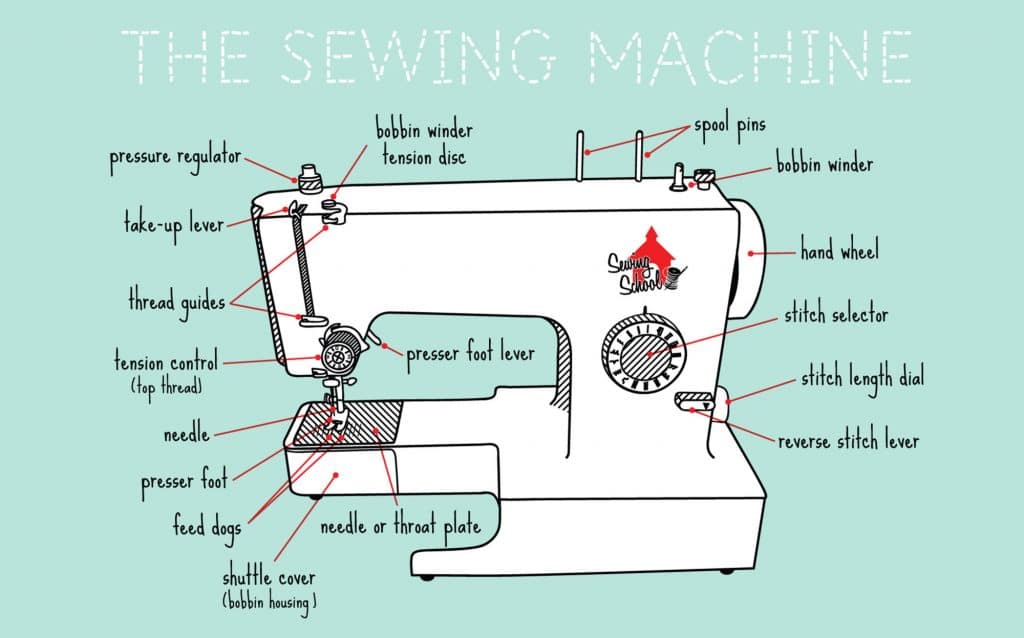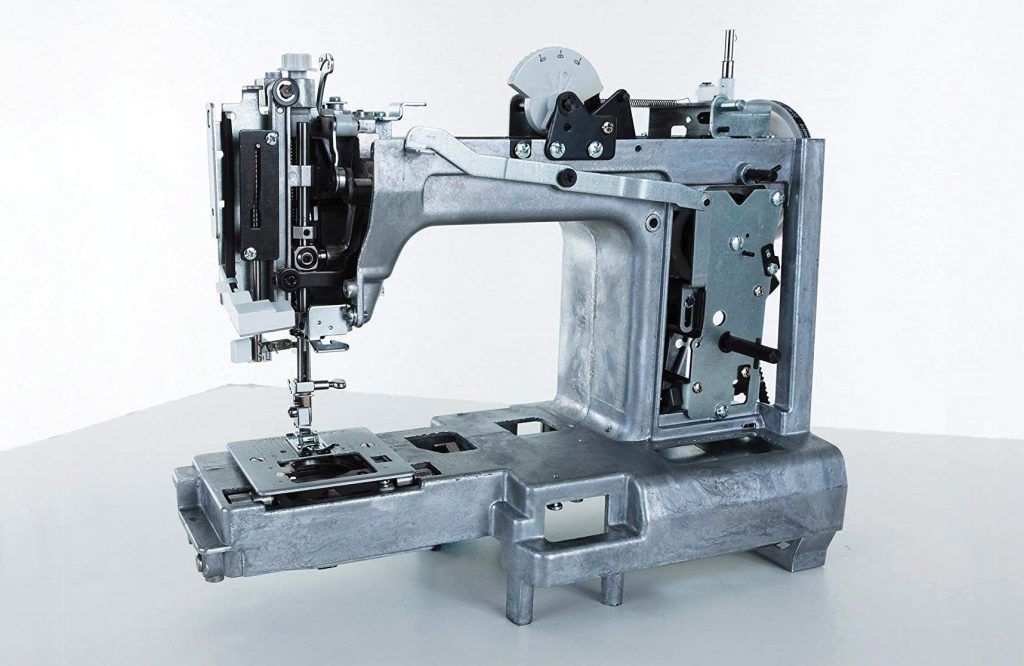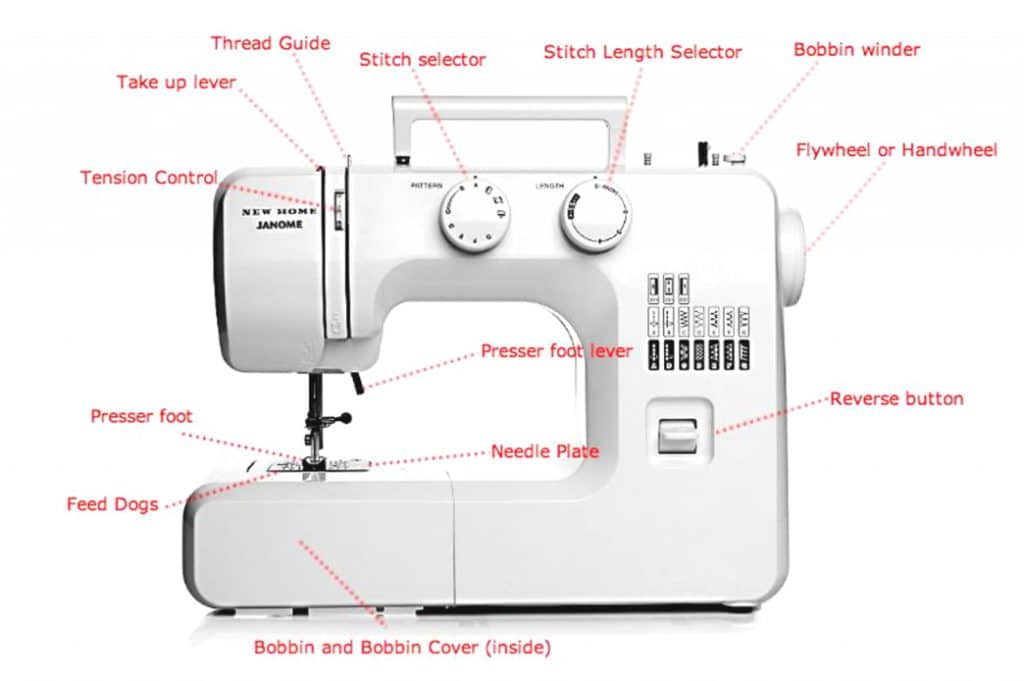

Before you invest in a sewing machine, there is an important factor you must consider; the sewing machine anatomy. Though sewing machines are all made with the same purpose kept in mind, they can be constructed differently depending on their brand.
Naturally, each brand will have their own method of construction, which will vary their sewing machines from others, with different features and aspects to offer. Since there is no solid anatomy for every sewing machine, we’ll be assessing the anatomy of better-known brand names. Singer, Brother, and Janome are three very prominent brands that create sewing machines for both conventional and hobbyist purposes. These brands are appropriate for a beginner and professional alike.
Before we break down each machine individually, the following are some general parts all sewing machines need in order to work properly.


The anatomy of a Singer sewing machine varies on the model type and added features, but the general idea with their machines remains the same.
The model in discussion here is the Heavy-Duty 4411 Sewing Machine Rom Singer, though some parts will be generalized to capture the overall idea of Singer products. There are, after all, well over 1000 Singer products to choose from.
They will all come with their own selection of stitches, controlled with a wheel selector. This selector is the stitch selection dial. Other dials present on this machine are stitch length adjustments, and stitch width adjustments up to 6mm. Singer usually goes with a drop-in bobbin rather than a front-loading design, although there are exceptions. The drop feed will help you with buttonholes and quilting. There is a lever to pull it down and the handwheel will return it back to its place. Most Singer machines will work with a foot pedal, which is directly attached to the power cord.
Singer sewing machine parts can also include a reverse lever, a free arm and removable storage compartments, Snap-on presser feet for a variety of jobs, a machine cover, and varying needle positions for easier stitching.
All Singer machines come with a high-powered motor and heavy-duty metal frame. Some machines do come with metal skin while others only use plastic on an aluminum frame. Accessories will vary depending on the model you’re looking at.
You will find many similarities with Brother sewing machine parts and Singer parts, but the assembly and additional features usually tends to differentiate the two machines.
Brother industrial machines come with the following components;

Not all of these will be present on one machine, but these are some of the industrial machine parts you can come across when looking at a Brother sewing machine. There are also domestic parts and accessories which you can find for Brother machines;
Once again, all of these parts may not be seen together inside of one Brother machine, but they are part of the variety you can expect to find. Brother machines also share the same metal frame and can either have sturdy metal or plastic skin over the mentioned frame.
Finally, we have Janome sewing machine parts. While Singer and Brother have an expanse audience of professionals and beginners alike, Janome targets more intense users. Most Janome machine come with advanced technology infused in them. With on-screen options and sleeker designs, Janome looks and feels different from the other two famous sewing machine brands.

Janome machines can have over 500 built-in stitches and embroidery designs to choose from. There is also an array of automatic features offered with each machine. Here are some automatic features you can encounter:
Janome products also come with on-screen functions and controls you can use while you are stitching. There are also a variety of applications you can use alongside your Janome machine. All of these five apps can be found on an iPad; AcuDesign, AcuEdit, AcuMonitor, AcuSetter, and AcuSketch.
Naturally, the higher quality and advanced technology used inside of these machines will place them at a higher price than Singer and Brother machines. It is possible, however, that the electronic models from Singer and Brother will reach around the same price as most Janome products.
Most Janome products will have gotten rid of many parts a manual sewing machine would otherwise not work without. Knobs, dials, wheels, and levers have all been removed from the Janome machines, replaced with digital screens and on-screen adjustment options. Janome sewing machines will therefore will be easier to handle since there are less accessories on the machine. Unfortunately, they tend to be very large and heavy, so they are not the most portable machines. They are ideal for commercial use, with a large assortment of state-of-the-art features.
Now that you have an idea of what some popular sewing machines look like, and what parts are present on sewing machines, it’ll be easier to understand how a sewing machine works.
The classical way to stitch by hand is called running stitch. The running stitch is easy enough to understand. Threading the thread through the eye of the needle, a knot is created at the end of the thread, so it does not simply slip out of the fabric. The needle is then pushed through the two or more fabric pieces used to stitch together, pulling the thread along with the stitch. Then, once the needle and thread are on the other side, the needle gets pushed back through the fabrics again. The thread that is left behind is called the stitch, and this is how the running stitch is used for small repairs and crafts.
But this is not how a sewing machine works. You know that the thread has to be on both sides of the fabric in order to stay in place, but the sewing machine will only ever stab through the fabric on one side and then immediately pull out the needle in reverse. How does this create a stitch?
This is where your bobbin and spool thread come into play. Remember, there are two threads being used in a sewing machine, not one. When the sewing machine pushes the needle through, a shuttle hook will catch the thread caught in the needle. The shuttle hook will then spin and stretch out the thread from the needle. While it spins, it catches the bobbin’s thread and weaves it through the needle’s thread. Once the needle is pulled back up, the two threads create a knot underneath the fabric which then creates a stitch. Not your classic running stitch at all.
If you’re still having trouble in understanding how a sewing machine works, then take a look at this explanation with animation to help explain it better:
It’s an easy process that we would not be able to perform by hand. The machine does this in a matter of seconds, and does it much more efficiently than we would ever. With the speed and strength of the stitches, it only makes sense to rely on a sewing machine to help you make clothes.
All sewing machines are made to serve the same purpose, and they stitch in the same way. They all use a bobbin and a thread of your choice to create stitches that hold your fabrics together. So why are some built differently?
It could be the purpose of the sewing machine. Some sewing machines are made for lightweight jobs while others are constructed for quilting. A sewing machine made for domestic purposes won’t be as robust and powerful as a commercial-grade sewing machine. Some sewing machines are made for portability, so they won’t have as many features as larger models. Latest electronic machines will have to change the anatomy of the machine entirely to accommodate the machinery and software required to operate the machine. There are so many different types of machines now, the anatomy does change from one to the other. But the necessary parts will remain the same.
The needle, the bobbin and spool, the presser feet, the arm and arm rest, the motor, all of these basics have to stay in order for the sewing machine to work. Their position may change from time to time, (bobbin in the front or top, spool on top or on the side) but their purpose and therefore importance does not change.
Brands will try to make their machines seem more attractive with accessories and convenience, which can also mean altering their design to appear unique. Singer and Brother, two brands which are very well-known and successful, have a standard design which is simple to understand and hasn’t changed drastically for all the years they have been around.
Janome is taking new innovative steps to create more technologically advanced machines with greater productivity and convenience for users. The implementation of screens has warped the classical look of sewing machines on their products.
But, so long as you know how a sewing machine works and the essential components required to ensure the sewing machine works, working on any sewing machine, manual or electronic, should be easy.